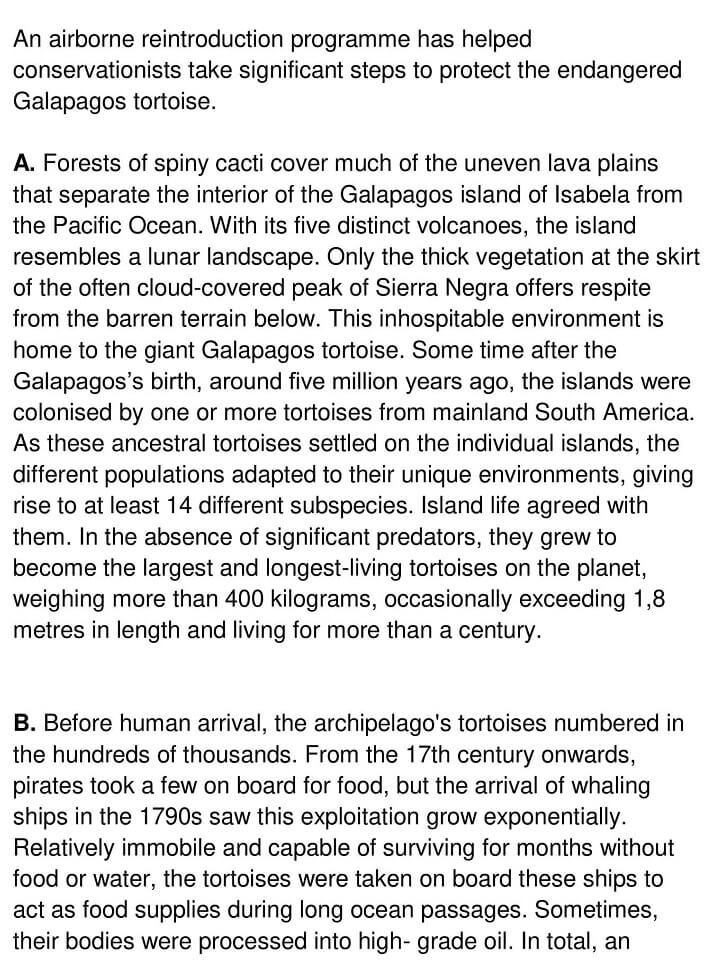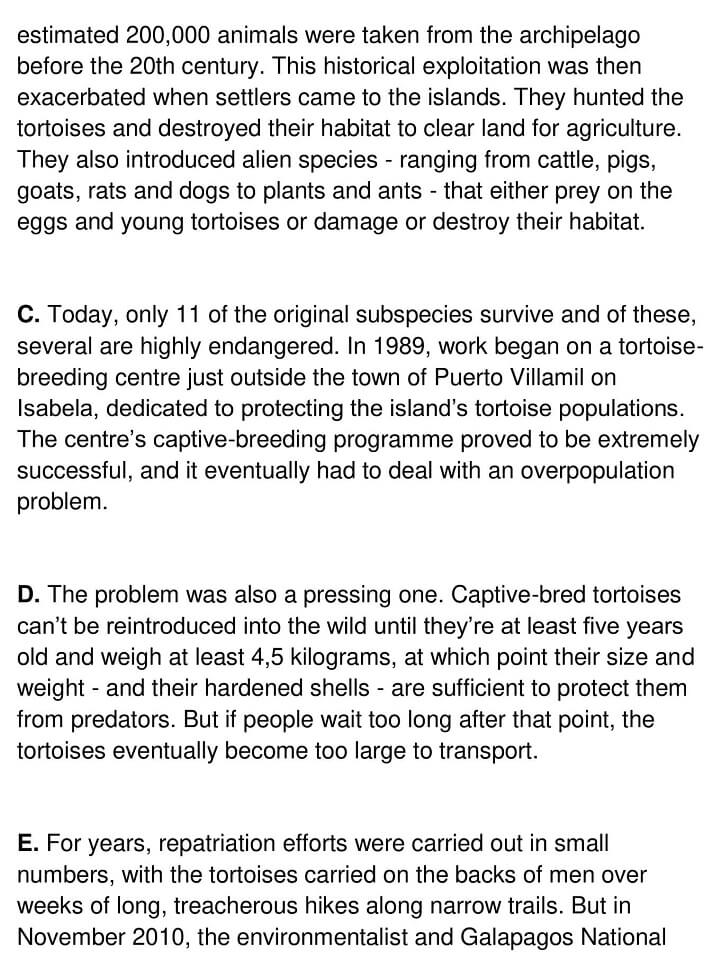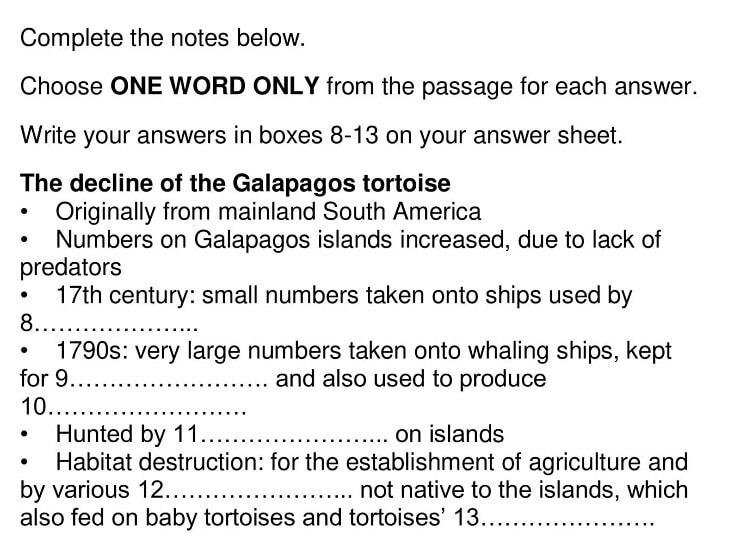Flying Tortoises – IELTS Reading Answers
6 min read
Updated On
-
Copy link
Table of Contents

Limited-Time Offer : Access a FREE 10-Day IELTS Study Plan!
The Academic passage ‘Flying Tortoises’ is a reading passage that appeared in an IELTS Test.
It contains some of the IELTS reading question types. If you are interested in familiarising yourself with all the question types, don’t hesitate to take an IELTS reading practice test.
Flying Tortoises





Answers
| Question number | Answer | Explanation |
|---|---|---|
| 1 | v | Paragraph A mentions that forests of spiny cacti cover much of the uneven lava plains that separate the interior of the Galapagos island of Isabela from the Pacific Ocean. With its five distinct volcanoes, the island resembles a lunar landscape. Only the thick vegetation at the skirt of the often cloud-covered peak of Sierra Negra offers respite from the barren terrain below. This inhospitable environment is ‘home to the giant Galapagos tortoise’ (tortoise populates the island). Hence, the answer is v (Tortoises populate the islands). |
| 2 | iii | Paragraph B lists how the arrival of humans affected the tortoise population. In total, ‘an estimated 200,000 animals were taken from the archipelago before the 20th century’. This historical exploitation was then exacerbated when ‘settlers came to the islands’. They ‘hunted the tortoises’ and ‘destroyed their habitat to clear land for agriculture.’ They also ‘introduced alien species – ranging from cattle, pigs, goats, rats, and dogs to plants and ants’ – that ‘either prey on the eggs and young tortoises or damage or destroy their habitat’. Hence, the answer is iii (Developments to the disadvantage of tortoise populations). |
| 3 | viii | Paragraph C states that today, only 11 of the original subspecies survive and of these, several are highly endangered. In ‘1989, work began on a tortoise-breeding centre’ just outside the town of Puerto Villamil on Isabela, ‘dedicated to protecting the island’s tortoise populations’ (conservation project). The ‘centre’s captive-breeding programme proved to be extremely successful’, and it eventually had to deal with an overpopulation problem. Hence, the answer is viii (The start of the conservation project). |
Unlock Answers
| 4 | i | Paragraph D informs that ‘captive-bred tortoises can’t be reintroduced into the wild until they’re at least five years old and weigh at least 4,5 kilograms’ (right timing), at which point their size and weight – and their hardened shells – are sufficient to protect them from predators. ‘But if people wait too long after that point’, the ‘tortoises eventually become too large to transport’. Hence, the answer is i (The importance of getting the timing right). |
| 5 | iv | Paragraph E notes that for years, ‘repatriation efforts were carried out in small numbers’, with the tortoises carried on the backs of men over weeks of long, treacherous hikes along narrow trails. But in ‘November 2010, the environmentalist and Galapagos National Park liaison officer Godfrey Merlin’, a visiting private motor yacht captain and a helicopter pilot ‘gathered’ around a table in a small cafe in Puerto Ayora on the island of Santa Cruz ‘to work out more ambitious reintroduction’ (plan a bigger idea). The aim was to ‘use a helicopter to move 300 of the breeding centre’s tortoises to various locations close to Sierra Negra’. Hence, the answer is iv (Planning a bigger idea). |
| 6 | vi | Paragraph F points out that during a period of three days, a ‘group of volunteers from the breeding centre worked around the clock to prepare the young tortoises for transport’ (carried out a prepared operation). Meanwhile, ‘park wardens dropped off ahead of time in remote locations, cleared landing sites’ within the thick brush, cacti and lava rocks. Hence, the answer is vi (Carrying out a carefully prepared operation). |
| 7 | ii | Paragraph G brings out the fact that upon their release, the ‘juvenile tortoises’ (young) quickly spread out over their ‘ancestral territory’, investigating their new surroundings and feeding on the vegetation. Eventually, ‘one tiny tortoise’ (young) ‘came across’ (met) a ‘fully grown giant’ (old) who had been lumbering around the island for around a hundred years. The two stood side by side, a ‘powerful symbol of the regeneration of an ancient species’. Hence, the answer is ii (Young meets old). |
| 8 | Pirates | Paragraph B refers to the fact that before human arrival, the archipelago’s tortoises numbered in the hundreds of thousands. From the ‘17th century’ onwards, ‘pirates’ took ‘a few’ (small number) ‘on board’ (onto ships) for food. Hence, the answer is ‘pirates’. |
| 9 | food | Paragraph B reveals that from the 17th century onwards, pirates took a few on board for food, but the arrival of ‘whaling ships in the 1790s’ saw this exploitation grow ‘exponentially’ (large number). Relatively immobile and capable of surviving for months without food or water, the tortoises were ‘taken on board’ (kept) these ships to ‘act as food supplies’ during long ocean passages. Hence, the answer is ‘food’. |
| 10 | Oil | Paragraph B states that from the 17th century onwards, pirates took a few on board for food, but the arrival of ‘whaling ships in the 1790s’ saw this exploitation grow ‘exponentially’ (large number). Relatively immobile and capable of surviving for months without food or water, the tortoises were ‘taken on board’ (kept) these ships to ‘act as food supplies’ during long ocean passages. Sometimes, their bodies were ‘processed’ (used to produce) into ‘high-grade oil’. Hence, the answer is ‘oil’. |
| 11 | Settlers | Paragraph B mentions that in total, an estimated 200,000 animals were taken from the ‘archipelago’ (island) before the 20th century. This historical exploitation was then exacerbated when ‘settlers came to the islands’. ‘They’ (settlers) ‘hunted the tortoises’. Hence, the answer is ‘settlers’. |
| 12 | Alien species | Paragraph B informs that in total, an estimated 200,000 animals were taken from the archipelago before the 20th century. This historical exploitation was then exacerbated when ‘settlers came to the islands’. ‘They’ (settlers) also introduced ‘alien species’ (not native to the islands) – ranging from cattle, pigs, goats, rats, and dogs to plants and ants. Hence, the answer is ‘alien species’. |
| 13 | eggs | Paragraph B informs that in total, an estimated 200,000 animals were taken from the archipelago before the 20th century. This historical exploitation was then exacerbated when ‘settlers came to the islands’. ‘They’ (settlers) also introduced alien species – ranging from cattle, pigs, goats, rats, and dogs to plants and ants – that either ‘prey’ (fed) ‘on the eggs’ and ‘young tortoises’ (baby tortoises) or damage or destroy their habitat. Hence, the answer is ‘eggs’. |
Check More IELTS Reading Answers
Also check :
Practice IELTS Reading based on question types

Start Preparing for IELTS: Get Your 10-Day Study Plan Today!
Recent Articles

Nehasri Ravishenbagam

Haniya Yashfeen

Haniya Yashfeen

Haniya Yashfeen




Post your Comments